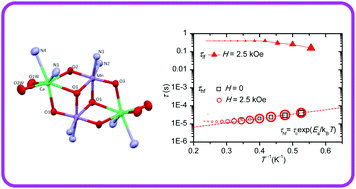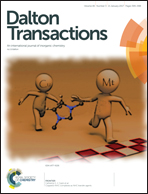Slow magnetic relaxation in a dimeric Mn2Ca2 complex enabled by the large Mn(iii) rhombicity†
Abstract
In this paper we present the characterization of a complex with the formula [Mn2Ca2(hmp)6(H2O)4(CH3CN)2](ClO4)4 (1), where hmp-H = 2-(hydroxymethyl)pyridine. Compound 1 crystallizes in the monoclinic space group C2/c with the cation lying on an inversion centre. Static magnetic susceptibility, magnetization and heat capacity measurements reflect a unique Mn(III) valence state, and single-ion ligand field parameters with remarkable large rhombic distortion (D/kB = −6.4 K, E/kB = −2.1 K), in good agreement with the high-field electron paramagnetic resonance experiments. At low temperature Mn2Ca2 cluster behaves as a system of ferromagnetically coupled (J/kB = 1.1 K) Mn dimers with a ST = 4 and mT = ±4 ground state doublet. Frequency dependent ac susceptibility measurements reveal the slow magnetic relaxation characteristic of a single molecule magnet (SMM) below T = 4 K. At zero magnetic field, an Orbach-type spin relaxation process (τ ∼ 10−5 s) with an activation energy Ea = 5.6 K is observed, enabled by the large E/D rhombicity of the Mn(III) ions. Upon the application of a magnetic field, a second, very slow process (τ ∼ 0.2 s) is observed, attributed to a direct relaxation mechanism with enhanced relaxation time owing to the phonon bottleneck effect.



 Please wait while we load your content...
Please wait while we load your content...